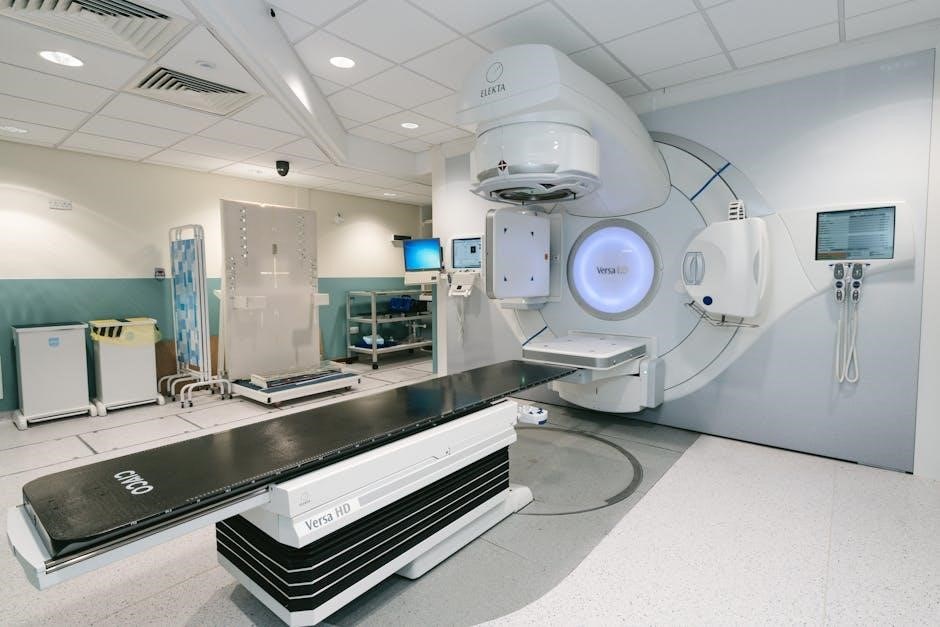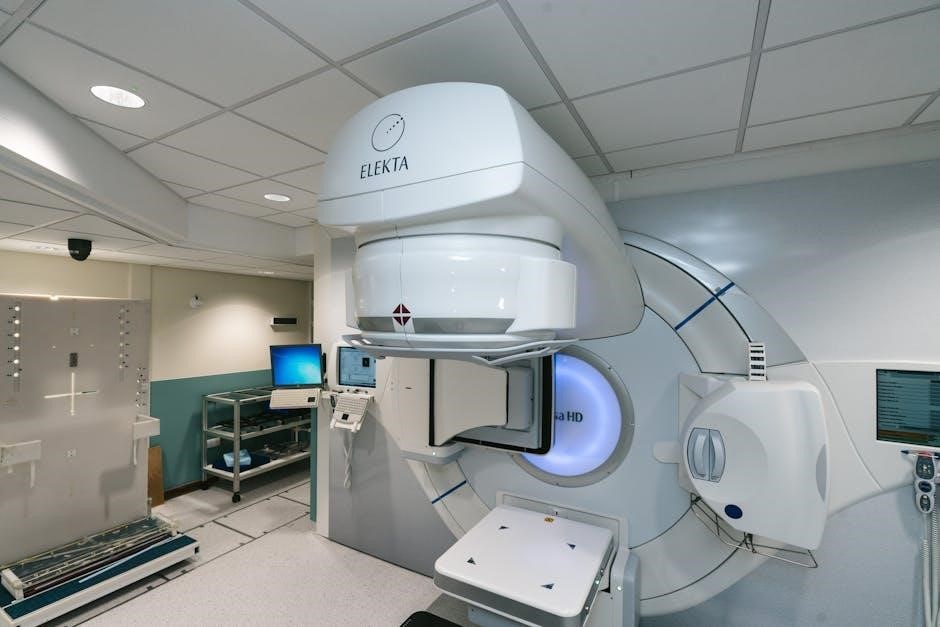Image-Guided Superficial Radiation Therapy (IGSRT) is a cutting-edge, non-invasive treatment for skin cancers, combining high-resolution imaging with precise radiation delivery for optimal outcomes and minimal side effects.
What is Image-Guided Superficial Radiation Therapy?
Image-Guided Superficial Radiation Therapy (IGSRT) is a non-invasive cancer treatment that combines high-resolution imaging with low-energy X-rays to precisely target cancer cells. It uses advanced imaging technologies, such as ultrasound, to guide the delivery of radiation, ensuring accurate treatment while sparing surrounding healthy tissue. IGSRT is primarily used for non-melanoma skin cancers, offering a safe and effective alternative to surgery with excellent cosmetic outcomes. Its integration of imaging and radiation delivery enhances precision, making it a modern advancement in oncology.

Development and Evolution of IGSRT
Image-Guided Superficial Radiation Therapy (IGSRT) evolved from traditional superficial radiation therapy (SRT), which dermatologists developed over a century ago. Recent advancements integrated high-resolution imaging, such as ultrasound, to enhance precision and outcomes. This fusion of radiation delivery with real-time imaging has transformed IGSRT into a cutting-edge treatment for skin cancers, offering improved accuracy and safety. Its development reflects ongoing innovations in oncology, combining historical therapeutic principles with modern technological advancements to address skin cancer effectively.
Key Features and Benefits of IGSRT
Image-Guided Superficial Radiation Therapy (IGSRT) combines high-resolution ultrasound imaging with precise radiation delivery, ensuring accurate tumor targeting. It offers non-invasive treatment, minimizing side effects and promoting superior cosmetic outcomes. The use of low-energy X-rays reduces damage to surrounding healthy tissue, making it ideal for skin cancers. IGSRT’s integration of real-time imaging enhances treatment safety and efficacy, providing patients with a reliable, non-surgical alternative for early-stage non-melanoma skin cancers with high success rates and minimal downtime.

How Image-Guided Superficial Radiation Therapy Works
Image-Guided Superficial Radiation Therapy (IGSRT) integrates advanced imaging technology with precise radiation delivery, ensuring accurate tumor targeting and effective treatment while minimizing exposure to surrounding healthy tissue.
The Role of Imaging in IGSRT
Imaging plays a crucial role in IGSRT by providing high-resolution visualization of tumors and surrounding tissue. Ultrasound and other advanced imaging technologies enable precise targeting of cancer cells, ensuring accurate radiation delivery. This real-time guidance allows for adjustments during treatment, enhancing precision and safety. Imaging also helps in monitoring tumor response and minimizing exposure to healthy tissue, making IGSRT a highly effective and safe treatment option for skin cancers.
Technologies Used in IGSRT
IGSRT employs advanced technologies such as high-resolution dermal ultrasound and precise X-ray delivery systems. These tools enable real-time visualization of tumors, ensuring accurate targeting of cancer cells while sparing healthy tissue. The integration of imaging and radiation delivery systems allows for precise dose administration, enhancing treatment efficacy and safety. These technologies are central to the effectiveness of IGSRT in managing skin cancers with minimal invasiveness and superior cosmetic outcomes.
The Radiation Delivery Process
IGSRT delivers precise, low-energy X-rays guided by real-time imaging, ensuring accurate targeting of cancer cells. The process involves positioning the patient, using imaging to confirm tumor location, and administering radiation in controlled doses. Advanced systems adjust beam angles and intensity for optimal coverage while minimizing exposure to surrounding tissue. This method allows for tailored treatment, enhancing effectiveness and safety, particularly for lesions in sensitive or hard-to-reach areas, ensuring minimal invasiveness and reduced side effects.

Advantages of Image-Guided Superficial Radiation Therapy
IGSRT offers high efficacy in treating skin cancers with minimal invasiveness, excellent cosmetic outcomes, and a high safety profile, making it a preferred non-surgical option for patients.
Efficacy in Treating Skin Cancers
Image-Guided Superficial Radiation Therapy (IGSRT) demonstrates exceptional efficacy in treating non-melanoma skin cancers, with studies showing over 99% freedom from recurrence at 2, 4, and 6 years. This high success rate is attributed to its precise targeting of cancer cells using ultrasound imaging, ensuring accurate radiation delivery while sparing surrounding healthy tissue. IGSRT’s effectiveness has established it as a reliable and preferred treatment option for early-stage skin cancers, offering superior clinical outcomes compared to traditional methods.
Non-Invasive Nature and Cosmetic Outcomes
IGSRT is a non-invasive treatment, eliminating the need for surgery and promoting faster recovery. Its precise radiation delivery minimizes damage to surrounding tissue, resulting in excellent cosmetic outcomes. Patients often experience minimal side effects, with skin appearing healthy post-treatment. This approach preserves the natural appearance of treated areas, making it a preferred option for individuals concerned about aesthetics. The non-invasive nature of IGSRT also reduces the risk of complications, ensuring a high level of patient satisfaction and improved quality of life.
High Safety Profile
IGSRT is renowned for its high safety profile, leveraging precise radiation delivery and real-time imaging to minimize exposure to healthy tissue. This reduces the risk of complications and side effects. The therapy’s non-invasive nature further enhances safety, avoiding surgical risks. Patients with sensitive or hard-to-treat areas benefit from this approach, as it ensures targeted treatment with minimal impact on surrounding skin. IGSRT’s safety makes it an ideal option for vulnerable populations, including older adults and those with complex medical conditions.
Clinical Applications of IGSRT
Image-Guided Superficial Radiation Therapy is primarily used to treat non-melanoma skin cancers, offering precise and effective treatment while minimizing damage to surrounding tissue. Its applications continue to expand.
Treatment of Non-Melanoma Skin Cancers
Image-Guided Superficial Radiation Therapy (IGSRT) is a groundbreaking treatment for non-melanoma skin cancers, such as basal cell carcinoma. By integrating high-resolution dermal ultrasound with superficial radiation, IGSRT provides precise tumor visualization and targeted radiation delivery. This minimally invasive approach achieves high cure rates, often exceeding 99%, while preserving healthy tissue. Its non-invasive nature and low side effects make it an ideal option for patients seeking effective, cosmetically favorable outcomes. IGSRT is particularly advantageous for treating lesions in sensitive areas, offering a safe and efficient alternative to surgery.
Other Applications Beyond Skin Cancer
Image-Guided Superficial Radiation Therapy (IGSRT) is increasingly being explored for treating non-cancerous conditions, such as keloids and benign tumors, due to its precision and minimal invasiveness. It also shows promise in managing certain types of lymphomas and cutaneous metastases. Additionally, IGSRT can be used for palliative care to alleviate symptoms like bleeding or pain in advanced cancers. Its versatility extends to treating lesions in sensitive areas, such as the face or neck, where surgical options may be limited or cosmetically unfavorable.
Research and Clinical Evidence Supporting IGSRT
IGSRT demonstrates high cure rates for non-melanoma skin cancers, with studies showing over 99% freedom from recurrence at 2, 4, and 6 years, supported by clinical trials and real-world outcomes.
Success Rates and Long-Term Outcomes
Image-Guided Superficial Radiation Therapy (IGSRT) has demonstrated exceptional success rates, with over 99% freedom from recurrence at 2, 4, and 6 years in clinical trials. This non-invasive treatment offers remarkable long-term outcomes, preserving healthy tissue and minimizing side effects. Patients benefit from excellent cosmetic results, with minimal scarring and maintained skin integrity. IGSRT’s precision, guided by advanced imaging, ensures targeted radiation delivery, making it a highly effective and reliable option for treating non-melanoma skin cancers compared to traditional therapies.
Comparative Studies with Traditional SRT
Studies comparing IGSRT with traditional superficial radiation therapy (SRT) highlight its superiority in precision and outcomes. IGSRT’s integration of advanced imaging ensures targeted radiation delivery, reducing side effects and improving cosmetic results. Unlike traditional SRT, IGSRT minimizes damage to surrounding healthy tissue, offering better long-term aesthetics. Clinical data show higher local control rates and lower recurrence with IGSRT, making it a preferred option for non-melanoma skin cancers compared to conventional methods.

Future Directions and Innovations in IGSRT
Future advancements in IGSRT focus on enhancing imaging technologies and expanding applications beyond skin cancer, potentially improving treatment efficacy and accessibility for various conditions.
Advancements in Imaging Technology
Recent advancements in imaging technology, such as high-resolution dermal ultrasound, have significantly improved tumor visualization in IGSRT. These innovations enable precise targeting of cancerous cells, reducing damage to surrounding healthy tissue. Enhanced imaging modalities, including real-time tracking and 3D reconstruction, are being explored to further refine treatment accuracy. Such technological progress is expected to broaden IGSRT’s applications and improve patient outcomes, making it a more versatile and effective treatment option.
Expanding Indications and Applications
IGSRT is increasingly being explored for applications beyond skin cancer, including benign conditions like keloid scars and certain superficial lesions. Clinical trials are investigating its efficacy in treating other types of cancers and non-cancerous conditions. The integration of advanced imaging technologies is enabling precise targeting of various tissue depths and types, broadening its potential uses. This expansion highlights IGSRT’s versatility and its growing role in modern oncology and dermatology, offering new treatment options for historically challenging conditions.
Image-Guided Superficial Radiation Therapy (IGSRT) represents a significant advancement in skin cancer treatment, offering a non-invasive, precise, and safe alternative to surgery. Its integration of advanced imaging ensures targeted radiation delivery, minimizing side effects and improving cosmetic outcomes. With expanding applications beyond skin cancer, IGSRT is poised to revolutionize oncology, providing effective and patient-centric care for a growing range of conditions. This innovative approach underscores its potential to enhance treatment efficacy and quality of life for patients worldwide.
